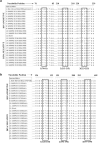Susceptibility to foot and mouth disease virus infection in vaccinated cattle, and host BoLA A and BoLA DRB3 genes polymorphism
- PMID: 35493756
- PMCID: PMC9005608
- DOI: 10.1007/s13337-021-00754-8
Susceptibility to foot and mouth disease virus infection in vaccinated cattle, and host BoLA A and BoLA DRB3 genes polymorphism
Abstract
The vaccination of the susceptible animal population against FMDV remains the most important measure to control the virus and prevent economic loss. Occurrence of infection in vaccinated animals is well-known in some diseases and is termed as breakthrough infection. The reasons include host genetic factors which can play an important role resulting in differences in susceptibility of animals to virus infection even with vaccine induced protective immune response. The Major Histocompatibility Complex (MHC) of bovines i.e. Bovine Leukocyte Antigen (BoLA) is important for antigen presentation. The BoLA DRB3 allele, which codes for the beta chain in Class II antigen, has been extensively studied and numerous reports have previously shown association of polymorphism in the gene with resistance/ susceptibility to several bacterial and viral diseases. In addition, previous studies have shown relationship between BoLA Class I and resistance or susceptibility to different diseases in cattle. The present study investigated the polymorphism in BoLA DRB3 and BoLA gene sequences of host and their relation with breakthrough FMDV infection in vaccinated animals. The study has identified three polymorphic sites each in both the genes which correlate with evidence of recent infection indicating their role in determining susceptibility of vaccinated animals to FMDV infection. Our limited study was performed on a relatively small samples size collected from one region of country. Further validation would require more detailed investigations on larger sample size.
Supplementary information: The online version contains supplementary material available at 10.1007/s13337-021-00754-8.
Keywords: BoLA A; BoLA DRB3; FMDV; Polymorphism.
© The Author(s), under exclusive licence to Indian Virological Society 2022.
Figures




Similar articles
-
Antibody response against three widespread bovine viruses is not impaired in Holstein cattle carrying bovine leukocyte antigen DRB3.2 alleles associated with bovine leukemia virus resistance.J Dairy Sci. 2009 Jan;92(1):375-81. doi: 10.3168/jds.2008-1143. J Dairy Sci. 2009. PMID: 19109295
-
BoLA-DRB3 Polymorphism is Associated with Differential Susceptibility to Bovine Leukemia Virus-Induced Lymphoma and Proviral Load.Viruses. 2020 Mar 22;12(3):352. doi: 10.3390/v12030352. Viruses. 2020. PMID: 32235771 Free PMC article.
-
BoLA-DRB3 Polymorphism Associated with Bovine Leukemia Virus Infection and Proviral Load in Holstein Cattle in Egypt.Pathogens. 2023 Dec 14;12(12):1451. doi: 10.3390/pathogens12121451. Pathogens. 2023. PMID: 38133334 Free PMC article.
-
Genetic variation and responses to vaccines.Anim Health Res Rev. 2004 Dec;5(2):197-208. doi: 10.1079/ahr200469. Anim Health Res Rev. 2004. PMID: 15984325 Review.
-
Graduate Student Literature Review: The DRB3 gene of the bovine major histocompatibility complex-Discovery, diversity, and distribution of alleles in commercial breeds of cattle and applications for development of vaccines.J Dairy Sci. 2024 Dec;107(12):11324-11341. doi: 10.3168/jds.2023-24628. Epub 2024 Jul 14. J Dairy Sci. 2024. PMID: 39004123 Review.
References
-
- Avendano C, Celis-Giraldo C, Ordonez D, Diaz-Arevalo D, Rodriguez-Habibe I, Oviedo J, Curtidor H, Garcia-Castiblanco S, Martinez-Panqueva F, Camargo-Castaneda A, Reyes C, Bohorquez MD, Vanegas M, Cantor D, Patarroyo ME, Patarroyo MA. Evaluating the immunogenicity of chemically-synthesised peptides derived from foot-and-mouth disease VP1, VP2 and VP3 proteins as vaccine candidates. Vaccine. 2020;38:3942–3951. doi: 10.1016/j.vaccine.2020.04.006. - DOI - PubMed
-
- Davenport MP, Quinn CL, Chicz RM, Green BN, Willis AC, Lane WS, Bell JI, Hill AV. Naturally processed peptides from two disease-resistance-associated HLA-DR13 alleles show related sequence motifs and the effects of the dimorphism at position 86 of the HLA-DR beta chain. Proc Natl Acad Sci U S A. 1995;92:6567–6571. doi: 10.1073/pnas.92.14.6567. - DOI - PMC - PubMed
LinkOut - more resources
Full Text Sources
Research Materials

